 W
WThis is a list of bird species confirmed in the Canadian province of Newfoundland and Labrador. The Bird Records Committee of Nature Newfoundland & Labrador lists 398 species as occurring in Newfoundland as of March 2016. Between that date and July 2020, 18 additional species have been added by eBird users. Of these 416 species, 112 are rare and 88 are very rare as defined below. Two were introduced to North America. One species is possibly extinct, and another species formerly found in Labrador is known to be extinct but is not on the Nature NL checklist.
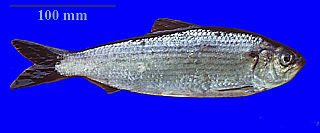 W
WThe alewife is an anadromous species of herring found in North America. It is one of the "typical" North American shads, attributed to the subgenus Pomolobus of the genus Alosa. As an adult it is a marine species found in the northern West Atlantic Ocean, moving into estuaries before swimming upstream to breed in freshwater habitats, but some populations live entirely in fresh water. It is best known for its invasion of the Great Lakes by using the Welland Canal to bypass Niagara Falls. Here, its population surged, peaking between the 1950s and 1980s to the detriment of many native species of fish. In an effort to control them biologically, Pacific salmon were introduced, only partially successfully. As a marine fish, the alewife is a US National Marine Fisheries Service "Species of Concern".
 W
WThe striped bass, also called Atlantic striped bass, striper, linesider, rock or rockfish, is an anadromous perciform fish of the family Moronidae found primarily along the Atlantic coast of North America. It has also been widely introduced into inland recreational fisheries across the United States. Striped bass found in the Gulf of Mexico are a separate strain referred to as Gulf Coast striped bass.
 W
WThe American butterfish, also known as the Atlantic butterfish, is a butterfish of the family Stromateidae.
 W
WThe Atlantic cod is a benthopelagic fish of the family Gadidae, widely consumed by humans. It is also commercially known as cod or codling. Dry cod may be prepared as unsalted stockfish, as cured salt cod or clipfish.
 W
WThe cusk or tusk is a North Atlantic cod-like fish in the ling family Lotidae. It is the only species in the genus Brosme. Other common names include Tusk, Torsk, European Cusk, Brosmius.
 W
WThe American smooth flounder is a flatfish of the family Pleuronectidae. It is a demersal fish that inhabits shallow inshore salt and brackish waters at depths of up to 27 metres (89 ft). Its native habitat is the temperate waters of the northwestern Atlantic, from Ungava Bay in Quebec, Canada to Rhode Island, United States. It can grow up to 30 centimetres (12 in) in length.
 W
WThe winter flounder, also known as the black back, is a right-eyed ("dextral") flatfish of the family Pleuronectidae. It is native to coastal waters of the western north Atlantic coast, from Labrador, Canada to Georgia, United States, although it is less common south of Delaware Bay. It is the most common near-shore (shallow-water) flounder in the waters from Newfoundland down through Massachusetts Bay, reaching a maximum size around 61 cm in length and 2.25 kg in weight. The species grows larger on Georges Bank, where they can reach a length of 70 cm and weight of 3.6 kg. Although winter flounder historically supported large commercial and recreational fisheries, biomass and landings have decreased since the 1980s.
 W
WThe yellowtail flounder is a species of fish in the family Pleuronectidae. It is found in the western North Atlantic from southern Labrador to Chesapeake Bay.
 W
WThe Atlantic halibut is a flatfish of the family Pleuronectidae. They are demersal fish living on or near sand, gravel or clay bottoms at depths of between 50 and 2,000 m. The halibut is among the largest teleost (bony) fish in the world, and is an endangered species due to a slow rate of growth and previous overfishing. Halibut are strong swimmers and are able to migrate long distances. Halibut size is not age-specific, but rather tends to follow a cycle related to halibut abundance.
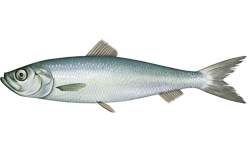 W
WAtlantic herring is a herring in the family Clupeidae. It is one of the most abundant fish species in the world. Atlantic herrings can be found on both sides of the Atlantic Ocean, congregating in large schools. They can grow up to 45 centimetres (18 in) in length and weigh up to 1.1 kilograms (2.4 lb). They feed on copepods, krill and small fish, while their natural predators are seals, whales, cod and other larger fish.
 W
WThe blue ling is a member of the cod family from the North Atlantic. It is usually 70 to 110 cm long, but the maximum length is 155 cm. Blue ling feed on fish and crustaceans and benthic invertebrates. The fish reaches sexual maturity at the age of six to 12 years.
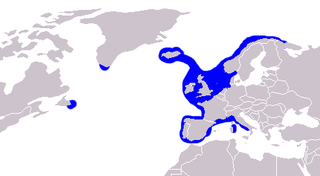 W
WThe common ling, also known as the white ling or simply the ling, is a large member of the family Lotidae, a group of cod-like fishes. It resembles the related rocklings, but it is much larger and has a single barbel. This species is unrelated to the pink ling, Genypterus blacodes, from the Southern Hemisphere. The common ling is found in the northern Atlantic, mainly off Europe, and into the Mediterranean Basin. It is an important quarry species for fisheries, especially in the northeastern Atlantic, although some doubts exist as the sustainability of the fisheries. As an edible species, it is eaten fresh, frozen, or dried, but also preserved in lye, while the roe is a delicacy in Spain.
 W
WThe American plaice, American sole or long rough dab is a North Atlantic flatfish that belongs, along with other right-eyed flounders, to the family Pleuronectidae. In the northwest Atlantic it ranges from Greenland and Labrador to Rhode Island, and in the northeast Atlantic it ranges from Murmansk to the English Channel, Ireland and Iceland. They live on soft bottoms at depths of 10 to 3,000 m (33–9,843 ft), but mainly between 90 and 250 m (300–820 ft).
 W
WThe saithe is a species of marine fish in the Pollachius genus. Together with Pollachius pollachius, it is generally referred to in the United States as pollock. Other names include the Boston blue, coalfish/coley, and saithe in the UK, the young fish are called podleys in Scotland and northern England.
 W
WThe Atlantic salmon is a species of ray-finned fish in the family Salmonidae which is the largest salmon and can grow up to a meter in length. It is found in the northern Atlantic Ocean and in rivers that flow into this ocean. Most populations of this fish species are anadromous, hatching in streams and rivers but moving out to sea as they grow where they mature, after which the adult fish seasonally move upstream again to spawn.
 W
WThe barndoor skate is a species of marine cartilaginous fish in the skate family Rajidae of the order Rajiformes. It is native to the northwestern Atlantic Ocean, and is found from the Grand Banks of Newfoundland and the southern side of the Gulf of St. Lawrence south to North Carolina. The fish is one of the largest skates found in the North Atlantic Ocean, reaching lengths up to 1.5 m (5 ft). It is carnivorous, feeding on invertebrates and other fish found near the sea floor.
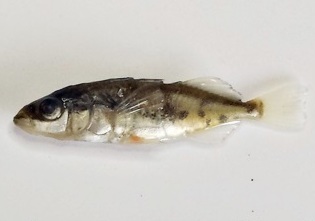 W
WThe blackspotted stickleback is a fish species, found in the western Atlantic from the coasts of Newfoundland (Canada) to Massachusetts. Brackishwater / marine benthic fish, up to 7.5 cm length.
 W
WThe three-spined stickleback is a fish native to most inland coastal waters north of 30°N. It has long been a subject of scientific study for many reasons. It shows great morphological variation throughout its range, ideal for questions about evolution and population genetics. Many populations are anadromous and very tolerant of changes in salinity, a subject of interest to physiologists. It displays elaborate breeding behavior and it can be social making it a popular subject of enquiry in fish ethology and behavioral ecology. Its antipredator adaptations, host-parasite interactions, sensory physiology, reproductive physiology, and endocrinology have also been much studied. Facilitating these studies is the fact that the three-spined stickleback is easy to find in nature and easy to keep in aquaria.
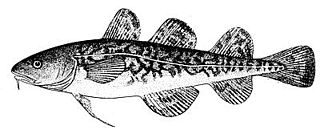 W
WMicrogadus tomcod, also commonly known as frostfish, Atlantic tomcod or winter cod, is a type of cod found in North American coastal waters from the Gulf of St. Lawrence, St. Lawrence River and northern Newfoundland, south to Virginia.